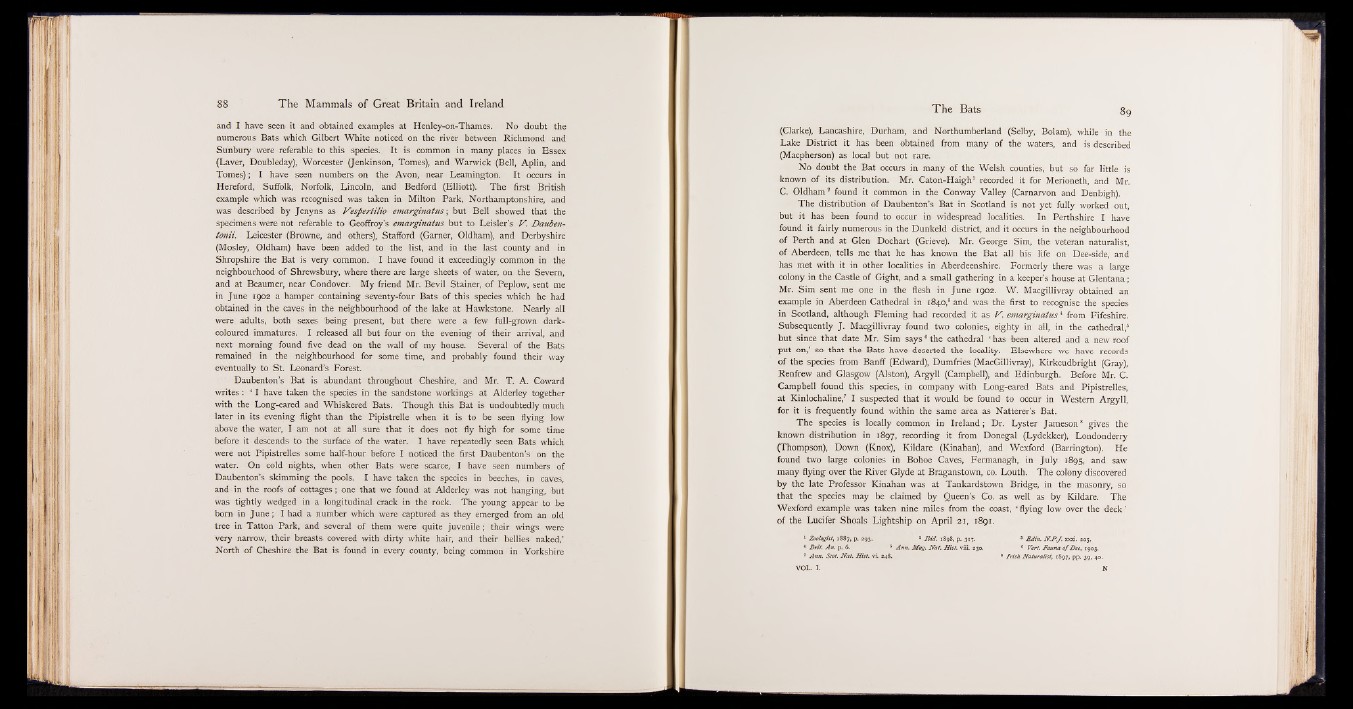
and I have seen it and obtained examples at Henley-on-Thames. No doubt the
numerous Bats which Gilbert White noticed on the river between Richmond and
Sunbury were referable to this species. It is common in many places in Essex
(Laver, Doubleday), Worcester (Jenkinson, Tomes), and Warwick (Bell, Aplin, and
Tomes); I have seen numbers on the Avon, near Leamington. It occurs in
Hereford, Suffolk, Norfolk, Lincoln, and Bedford (Elliott). The first British
example which was recognised was taken in Milton Park, Northamptonshire, and
was described by Jenyns as Vespertilio emarginatus; but Bell showed that the
specimens were not referable to Geoffroy’s emarginatus but to Leisler’s V. Dauben-
tonii. Leicester (Browne, and others), Stafford (Garner, Oldham), and Derbyshire
(Mosley, Oldham) have been added to the list, and in the last county and in
Shropshire the Bat is very common. I have found it exceedingly common in the
neighbourhood of Shrewsbury, where there are large sheets of water, on the Severn,
and at Beaumer, near Condover. My friend Mr. Bevil Stainer, of Peplow, sent me
in June 1902 a hamper containing seventy-four Bats of this species which he had
obtained in the caves in the neighbourhood of the lake at Hawkstone. Nearly all
were adults, both sexes being present, but there were a few full-grown dark-
coloured immatures. I released all but four on the evening of their arrival, and
next morning found five dead on the wall of my house. Several of the Bats
remained in the neighbourhood for some time, and probably found their way
eventually to St. Leonard’s Forest.
Daubenton’s Bat is abundant throughout Cheshire, and Mr. T. A. Coward
writes: ‘ I have taken the species in the sandstone workings at Alderley together
with the Long-eared and Whiskered Bats. Though this Bat is undoubtedly much
later in its evening flight than the Pipistrelle when it is to be seen flying low
above the water, I am not at all sure that it does not fly high for some time
before it descends to the surface of the water. I have repeatedly seen Bats which
were not Pipistrelles some half-hour before I noticed the first Daubenton’s on the
water. On cold nights, when other Bats were scarce, I have seen numbers of
Daubenton’s skimming the pools. I have taken the species in beeches, in caves,
and in the roofs of cottages ; one that we found at Alderley was not hanging, but
was tightly wedged in a longitudinal crack in the rock. The young appear to be
born in June; I had a number which were captured as they emerged from an old
tree in Tatton Park, and several of them were quite juvenile; their wings were
very narrow, their breasts covered with dirty white hair, and their bellies naked.’
North of Cheshire the Bat is found in every county, being common in Yorkshire
(Clarke), Lancashire, Durham, and Northumberland (Selby, Bolam), while in the
Lake District it has been obtained from many of the waters, and is described
(Macpherson) as local but not rare.
No doubt the Bat occurs in many of the Welsh counties, but so far little is
known of its distribution. Mr. Caton-Haigh1 recorded it for Merioneth, and Mr.
C. Oldham2 found it common in the Conway Valley (Carnarvon and Denbigh).
The distribution of Daubenton’s Bat in Scotland is not yet fully worked out,
but it has been found to occur in widespread localities. In Perthshire I have
found it fairly numerous in the Dunkeld district, and it occurs in the neighbourhood
of Perth and at Glen Dochart (Grieve). Mr. George Sim, the veteran naturalist,
of Aberdeen, tells me that he has known the Bat all his life on Dee-side, and
has met with it in other localities in Aberdeenshire. Formerly there was a large
colony in the Castle of Gight, and a small gathering in a keeper’s house at Glentana ;
Mr. Sim sent me one in the flesh in June 1902. W. Macgillivray obtained an
example in Aberdeen Cathedral in 1840,8 and was the first to recognise the species
in Scotland, although Fleming had recorded it as V. emarginatus4 from Fifeshire.
Subsequently J. Macgillivray found two colonies, eighty in all, in the cathedral,6
but since that date Mr. Sim says6 the cathedral ‘ has been altered and a new roof
put on,’ so that the Bats have deserted the locality. Elsewhere we have records
of the species from Banff (Edward), Dumfries (MacGillivray), Kirkcudbright (Gray),
Renfrew and Glasgow (Alston), Argyll (Campbell), and Edinburgh. Before Mr. C.
Campbell found this species, in company with Long-eared Bats and Pipistrelles,
at Kinlochaline,7 I suspected that it would be found to occur in Western Argyll,
for it is frequently found within the same area as Natterer’s Bat.
The species is locally common in Ireland; Dr. Lyster Jameson8 gives the
known distribution in 1897, recording it from Donegal (Lydekker), Londonderry
(Thompson), Down (Knox), Kildare (Kinahan), and Wexford (Barrington). He
found two large colonies in Bohoe Caves, Fermanagh, in July 1895, and saw
many flying over the River Glyde at Braganstown, co. Louth. The colony discovered
by the late Professor Kinahan was at Tankardstown Bridge, in the masoniy, so
that the species may be claimed by Queen’s Co. as well as by Kildare. The
Wexford example was taken nine miles from the coast, ‘ flying low over the deck’
of the Lucifer Shoals Lightship on April 21, 1891.
1 Zoologist, 1887, p. 293. * Ibid. 1898, p. 317. * Edin. N .P.J. xxxi. 205.
4 B rit. An. p. 6. * Ann. Mag. Nat. H ist. viii. 230. 6 Vert. Fauna o f Dee, 1903.
7 Ann. Scot. Nat. H ist. vi. 248. 8 Irish Naturalist, 1897, pp. 39, 40.
VOL. I.